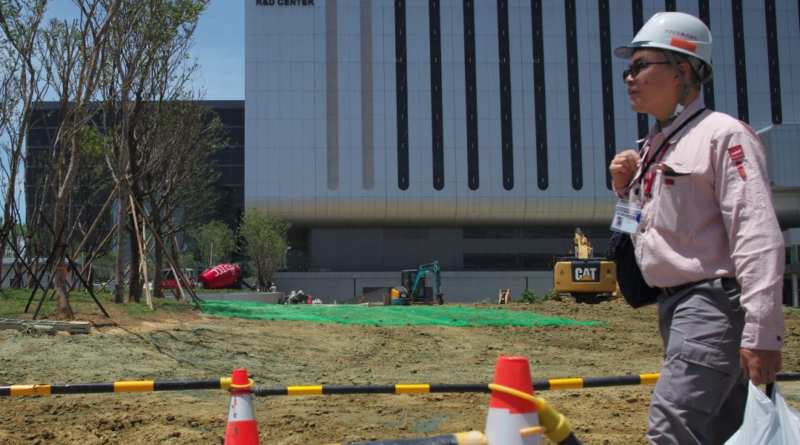How chipmaker TSMC bolstered its foundry to fend off Taiwan's biggest earthquake in 25 years – Fortune
Taiwan Semiconductor Manufacturing Company (TSMC), the semiconductor-chip-making juggernaut, evacuated its workers after a 7.4-magnitude earthquake rocked the country on Wednesday, reporting no major damages. Its employees returned to work only hours after aftershocks rippled through the island. It’s not the company’s first rodeo when it comes to navigating natural disasters.
TSMC, the primary chip supplier for Apple and AI darling Nvidia, told Fortune it moved workers from some of its production centers as a precautionary measure and temporarily halted operations during the earthquake and its immediate aftershocks. While the company reported damage in a “small number” of tools and has an ongoing inspection to assess full damages, it said its fabrication plants recovered 70% of tools within 10 hours of the earthquake, and that its “critical tools,” such as its multimillion-dollar extreme ultraviolet lithography tools, remain unharmed.
“TSMC is deploying all available resources for full recovery, and impacted facilities are expected to resume production throughout the night,” TSMC said in a statement to Fortune.
The manufacturer, as indicated by its damage limitations, is no stranger to being nimble in the face of natural disaster. Taiwan has about 2,200 earthquakes a year, according to the Central Weather Administration Seismological Center, over 200 of which can be felt. The ubiquity of these events has simply forced the company to make necessary changes to its operations.
“Seismic activity is a huge challenge for firms carrying out the most precise manufacturing processes of any industry,” Mark Williams, chief Asia economist of Capital Economics, wrote in an April 3 note. “But it is one that Taiwanese chipmakers have grown up with.”
TSMC did not tell Fortune the conclusions of its inspection or how the work stoppage will impact business, but there is a precedent for Wednesday’s setbacks: In 2016, a 6.6-magnitude earthquake shook TSMC’s Tainan fabrication plants. Following the disaster, the company insisted that the quake wouldn’t impact first-quarter shipments more than 1%. Indeed, wafer chip shipments saw a 1.8% quarter-over-quarter dip, but revenue for the quarter plummeted 8.3%.
“Although the February 6 earthquake caused some delay in wafer shipments in the first quarter, we saw business upside resulting from demand increases in mid- and low-end smartphone segments and customer inventory restocking,” Lora Ho, TSMC senior vice president of human resources and then CFO, said in its 2016 first-quarter earnings report.
Following the disaster, TSMC strengthened the ceilings of its facilities with bracings and added stoppers to its tower stocker shelves to prevent slippage.
It took a massive natural disaster for TSMC to begin seriously revising its protocols and infrastructure. The benchmark for Wednesday’s 7.4-magnitude quake was 1999’s 7.6–magnitude shock, which saw 2,415 people killed and over 11,000 injured, and caused $300 million in damages.
Following the 1999 quake, TSMC improved seismic coefficient, or loads offsetting seismic activity—25% more than legally required for its new main buildings—and added additional anchors on its equipment. It made additional incremental changes to its infrastructure, including dampers that disperse kinetic energy caused by earthquakes, that reduced the seismic activity felt by buildings by 15%–20%. In 2015, TSMC installed an earthquake early warning system. The company did not respond to Fortune’s request for comment on changes it plans to make following Wednesday’s natural disaster.
TSMC’s earthquake preparedness is a cross-section of the changes Taiwan has made to its infrastructure to mitigate earthquake-related damages and fatalities. While more than 300,000 households lost power after the Wednesday quake, 70% had power restored by 9:30 a.m.
Wu Yih-min, a professor of geosciences at National Taiwan University and a team leader at the National Science and Technology Center for Disaster Reduction, told Bloomberg that Taiwan has developed a disaster response team in the past three to five years to manage catastrophes. The team can scan information online to inform where it sends assistance and can detect mobile signals and view screenshots from surveillance footage to assess damages and foot traffic patterns.
“Taiwan continues to develop these technologies, and we have advantages,” Wu said.
© 2024 Fortune Media IP Limited. All Rights Reserved. Use of this site constitutes acceptance of our Terms of Use and Privacy Policy | CA Notice at Collection and Privacy Notice | Do Not Sell/Share My Personal Information
FORTUNE is a trademark of Fortune Media IP Limited, registered in the U.S. and other countries. FORTUNE may receive compensation for some links to products and services on this website. Offers may be subject to change without notice.
